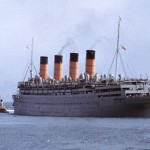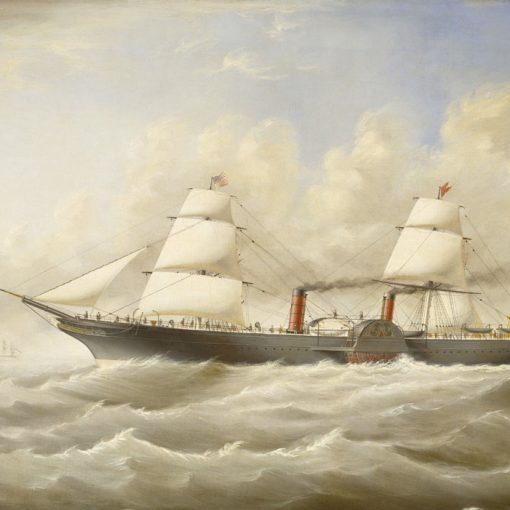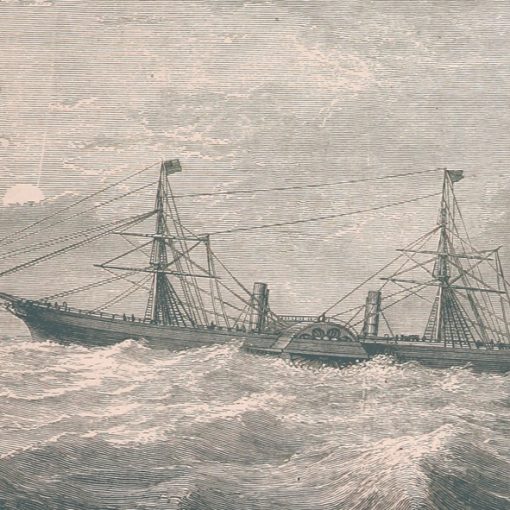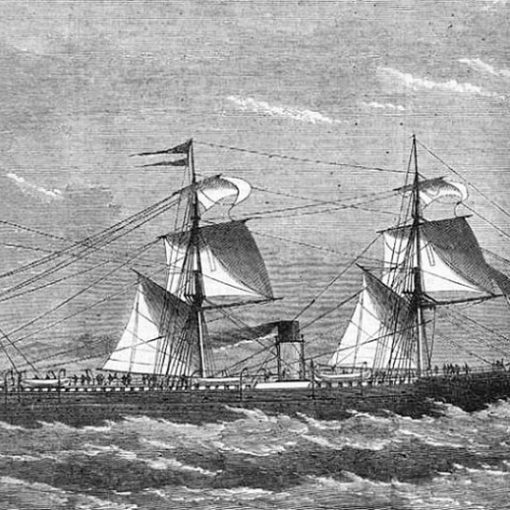1914 – 1950
Ever since the Germans had taken the distinction of having the fastest ship in the world with the Kaiser Wilhelm der Grosse in 1897, the British had wanted to strike back. The first step was taken by the White Star Line when they put the Celtic in service in 1901. This ship was the first to exceed the Great Eastern from 1860 in size, but despite her being a rather slow ship at 16 knots, she had regained much of Britain’s lost honour. The Celtic was followed by four sisters until 1907 – the Cedric, Baltic and Adriatic. By then, the British Cunard Line was eager to have a piece of the cake as well, and they had commissioned the fabulous Lusitania at 31,000 tons. She was followed by her sister Mauretania only months later. These two ships secured Britain’s position as the leading nation in merchant shipping. The Cunard Line now both had the fastest and largest vessels in the world – all in one set of ships. Now that the White Star Line had been surpassed, they felt that their business needed a continued race. In 1911, they put the enormous 45,000-ton Olympic in service and she immediately became a success. She was followed with her sister Titanic in 1912, but as she tragically sank on her maiden voyage with the loss of 1,500 lives, White Star’s reputation was in deep trouble once again. As fate would have it, Cunard did not have to worry about the White Star Line anymore.
As Olympic and Titanic had surpassed Lusitania and Mauretania with a staggering 15,000 tons, Cunard did not hesitate to put a liner in service to match the remaining Olympic. Cunard hired Leonard Peskett to do the design work. He was the same man who had designed the Mauretania and that well suited Cunard’s demand to make the new ship into a larger replica of her older sister. Even the old four-funnel design would be copied. John Brown – the same shipyard that had built the Lusitania – was selected to construct the new liner for Cunard. When the Titanic-disaster occurred in April 1912, the Aquitania was under construction, and so additional lifeboats could be put in place before the ship entered service – an advantage she had before ships like Olympic and Mauretania.
On April 21st, 1913 the new companion to the Lusitania and Mauretania was launched and christened Aquitania. Cunard followed their tradition in having their ships named after Roman provinces, and the Aquitania’s name came from and area in today’s southwest France. After the launch, the fitting out could commence. The work took some thirteen months, and on May 29th, 1914 the Aquitania entered service as she was pulled out from the Liverpool docks. The event was darkened somewhat since Canadian Pacific Line’s Empress of Ireland had sunk in Canada with a heavy loss of life.
For the Aquitania’s passengers, the thrilling thing about the ship was not her speed. The Lusitania and Mauretania were able to cross the Atlantic with an average speed of approximately 25-26 knots, but the third of the trio would have a limited power for 23 knots. Except for her size – the largest Cunard-built liner until the arrival of the Queen Mary – the most thrilling thing about her was her marvellous interiors. Where her running mates concentrated on speed, Aquitania focused on luxurious passenger areas. The columned Palladian lounge rose through two decks as well the Louis XVI-style first class dining room, the large smoking rooms appearance had been copied from the Royal Naval College in London, creating that shore side feeling that ship designers wanted to put on ships prior to the great change that came in 1927 with the Île de France. These fantastic interiors earned the Aquitania the nickname ‘Ship Beautiful’.
Some refer to the Aquitania’s exteriors as exceptionally well made and pleasing to the eye as well, but the author of this article agrees with John Maxtone-Graham when he compares the Aquitania with the Olympic: ‘Both Olympic and Aquitania had nine passenger decks but because Peskett had dispensed with a raised fo’c’s’le head on the new Cunarder, more of his bridge front was exposed; there seemed too many decks. Overall the Aquitania’s superstructure appeared too large and burdensome for her hull, a state of imbalance that Carlisle’s Olympic-design avoided completely. Peskett gave the masts and the four working funnels of the Aquitania a nine-degree rake but it failed to temper the ship’s boxy, somewhat clumpsy look.’ But this is only in comparison with the Olympic’s lean grace where almost no other ships come close. Of course the Aquitania was a beautiful ship, and when compared to the horrible cruise ships of today you instinctively know where you would have liked to sail. The description by Maxtone-Graham above could well fit in with as a sort of comparison between QE2 and Destiny. Traditionalism against new thinking – where the new thinking has not always got to be the best solution.
After having completed only a few trans-Atlantic crossings between Southampton and New York, World War I erupted with the German Kaiser’s attack. The Aquitania was called in to serve her mother country as part of the Royal Navy. At first, she was converted into an armed merchant cruiser patrolling the seas. This however proved to be somewhat out of place as all the liners put in this kind of service quickly devoured all of Britain’s coal supplies. Consequently, she was converted into a troop-ship steaming across the oceans, just as she was intended to do. When the end of the war neared she was again converted, this time into a hospital ship. One of her many duties in this guise was to serve in the Mediterranean along with White Star Line’s latest and largest addition – Britannic.
When the hostilities ended in 1918, Britain and France stood victorious over Germany and Austria when they signed the unconditional surrender at Versailles. At last, the Aquitania could return to the commercial service she was intended for. But she did not return to the same Cunard Line she had served in before the war. Cunard Line had lost 22 vessels during the hostilities, among them Lusitania who had been sunk by a German torpedo in 1915. At first, Cunard intended to fill the Lusitania’s place with the Holland Amerika Line’s Justicia, but soon a much more tempting offer came. As Germany had lost the war, they had to pay the penalty. Among other things, this consisted in giving all appropriate merchant tonnage to the victorious states. The 52,000-ton Imperator, who had taken the title of being the largest ship in the world from White Star’s Olympic-class, now was in Cunard’s aim. After some trooping crossings under the American flag she was handed over to the Cunard Line in 1919. They immediately renamed her Berengaria and painted her in Cunard’s conventional livery. The Cunard fast duo from the early years of the century was now turned into a trio consisting of Berengaria, Aquitania and Mauretania. They were called ‘The Big Three’.
Just as so many other major vessels, the Aquitania was converted from coal-firing to oil-firing during her post war refit. This bettered her performance somewhat and at several occasions she made crossings in the vicinity of 24 knots. During this refit, her bridge front was changed to an even ‘clumsier’ look. The officers had complained that the bridge was too far down – or the rest of the ship way too large – and they could not see properly over the bows. To alter this, a new bridge house was place on top of where the old one had been.
As times grew better and better, the Aquitania grew into the role of being one of the most profitable ocean liners in all history. The American restriction of immigrants in the early Twenties ended the age of mass-emigration from Europe, but as ocean travel was the only means of transportation across the continents, the ocean liners survived – and even surpassed old records. Some of the big money now came in from movie stars and royalty, other aristocracy and politicians. The Aquitania became their favourite, as the 1920s became one of the most profitable ages in ocean travel history.
In 1929 the terrible financial crash at Wall Street, New York occurred. The disaster was so immense that it is said that ruined millionaires threw themselves one after one from the tops of the city’s skyscrapers. The crash affected everything sooner or later, by all means the ocean liners as well. Suddenly only a small selected group of people could still afford to go on an expensive voyage across the seas. Many of the liners that often used to be booked solid now steamed into the harbours of the Atlantic with more crew than passengers on board. Some of the ships that seemed to suffer more than others were old ships like the Celtic-class – all four still intact after World War I – and the Olympic. The medicine for the shipping lines was to send their grand ships on cheap cruises in warmer climates. This tempted many Americans, as they were tired of their country’s prohibition against alcohol. Since most of the North Atlantic ships now in cruise service were European they could escape the rules for some time. The Aquitania still managed to maintain her excellent reputation, and was not faced with the same struggle as many other vessels during these years.
Even though White Star was the company with the most problems, Cunard had begun to suffer severely in the mid-Thirties as well. As they were constructing an 80,000-tonner to rival the French Normandie of similar size they were desperate for help. Once again, they turned to the British Government just as they had done when about to build Lusitania and Mauretania. This time, the Government required Cunard to join forces with White Star in order to secure financial success. White Star was also building a competitor to Normandie and the future Queen Mary, but economic disaster had struck them immensely and they had to abandon the project of the Oceanic. They saw the possibility to take part of the Queen Mary when joining Cunard, and after some negotiation, a new shipping company emerged – Cunard White Star. Cunard had 62 per cent of the votes in the company.
This meant that the Aquitania suddenly had became a running mate to some of her biggest rivals. White Star’s Big Three – Majestic, Olympic and Homeric – now served alongside Cunard’s Big Three – Berengaria, Aquitania and Mauretania. But as the new management settled they hastingly made up plans to send much of its old tonnage to the scrap yard. The ageing Adriatic only made a few voyages in 1934 before she was sent to Japan for demolition. Shortly after that, the much loved Mauretania left Southampton for the last time just as the Homeric, and later both the Olympic and Majestic as well. The Aquitania was planned to be kept in service until the arrival of the Queen Mary’s younger sister Queen Elizabeth’s arrival in 1940.
During this period of time one of the Aquitania’s greater mistakes occurred. When inbound to Southampton from a Mediterranean cruise in the mid-Thirties, the Aquitania went aground and was stuck in the same position for 26 hours before the power of eleven tugs pulled her away. Despite having resting with her hull on the bottom with a terrible strain for more than a whole day, the Aquitania seemed to have had gone through the incident almost unscathed. She was back in service shortly afterwards.
Cunard’s plans of keeping the Aquitania until 1940 was scattered to the wind when Adolf Hitler of Germany marched into Poland and pulled the trigger to World War II. Alongside with highly distinguished ships such as Queen Mary, Queen Elizabeth, Normandie and Île de France, the Aquitania now joined the Royal British Navy on the task of eliminating the attacking enemies. At one occasion, in September 1939, the harbour of New York enjoyed the task of serving a very selected group of ships. At pier 88 lay the Île de France and the Normandie, berthed at pier 90 were the Queen Mary and the Aquitania, and finally at pier 92 lay the Italia Line’s former Blue Riband champion Rex – all intended for war use sooner or later except for the Rex who tried to maintain a passenger service across the Atlantic as long as possible.
During the hostilities, the Aquitania performed brilliantly, completing a large number of trans-Atlantic crossings in trooping purposes. Just as the Queens, the Aquitania surely contributed to shorten the war with a few years. When Germany capitulated in 1945, the war tasks were far from over for the liners. Before they returned to their commercial service they completed the transportation of troops back to their homes. In Aquitania’s case, this lasted until 1949 when she was handed back to the Cunard Line.
The Aquitania was not refitted as a luxury liner, but she was returned to a sort of passenger service. Some of her luxurious furniture that had been taken off before the war was never put back on board, but instead placed in the former White Star vessel Britannic. From now on to an uncertain future, the Aquitania shipped emigrants between Southampton and Halifax.
She only lasted in this service for another year, when Cunard realised how old their once fabulous Aquitania had become. In late 1949, a piano almost crashed through to the deck below when a ceiling gave way. She was falling apart everywhere. Some of the bulkheads were nearly rusted through, and the funnels almost fell onto the decks, as they were thin like stamps due to heavy corrosion. The last of the mighty four stackers were sent to the scrappers in February 1950. She had served ever since 1914, carried out her duties in two major conflicts and steamed over three million miles, completing nearly 450 voyages. With the disappearance of the Aquitania, the last of the genuine ‘floating palaces’ from before World War I was gone.
Specifications
- 901 feet (275.2 m) long
- 97 feet (29.6 m) wide
- 45,647 gross tons
- Steam turbines powering four propellers
- 23 knot service speed
- Passenger capacity of 3,230 people
















4 thoughts on “Aquitania”
The White Star vessel Britannic was sunk on 21st November 2016 so it would surprising that the luxurious furniture that had been taken off before the 1939 war would then be put on Britannic.
There were three ships called Britannic: the second sank during WW1, the third was in service from 1930 to 1960.
The idea that Aquitania was in such a state of disrepair towards the end of her career is nothing more than a legend. There is no record of such events occurring and it has been debunked by historian Mark Chirnside, who managed to obtain, from the Cunard archives in Liverpool, a record of defects that were noticed and repaired throughout Aquitania’s career, and nowhere does it mention decks failing, funnels almost collapsing and a piano crashing through the deck. The ship was regularly scanned for issues like this, and such defects would have surely been noticed right away and fixed long before reaching such a point of disrepair.
Cunard could not have had the Justicia as a post war replacement for the Lusitania since she had been sunk in July 1918. In fact, it is unlikely that this was ever a consideration. Not only because Justicia was a much slower vessel (capable of only 18 knots) compared to Mauretania and Aquitania, but had she survived the war, she would have been returned to her original owners (Holland America) and doubtlessly, her name would have reverted back to Statendan.